Renhao Wang
Visually Prompted Benchmarks Are Surprisingly Fragile
Dec 19, 2025Abstract:A key challenge in evaluating VLMs is testing models' ability to analyze visual content independently from their textual priors. Recent benchmarks such as BLINK probe visual perception through visual prompting, where questions about visual content are paired with coordinates to which the question refers, with the coordinates explicitly marked in the image itself. While these benchmarks are an important part of VLM evaluation, we find that existing models are surprisingly fragile to seemingly irrelevant details of visual prompting: simply changing a visual marker from red to blue can completely change rankings among models on a leaderboard. By evaluating nine commonly-used open- and closed-source VLMs on two visually prompted tasks, we demonstrate how details in benchmark setup, including visual marker design and dataset size, have a significant influence on model performance and leaderboard rankings. These effects can even be exploited to lift weaker models above stronger ones; for instance, slightly increasing the size of the visual marker results in open-source InternVL3-8B ranking alongside or better than much larger proprietary models like Gemini 2.5 Pro. We further show that low-level inference choices that are often ignored in benchmarking, such as JPEG compression levels in API calls, can also cause model lineup changes. These details have substantially larger impacts on visually prompted benchmarks than on conventional semantic VLM evaluations. To mitigate this instability, we curate existing datasets to create VPBench, a larger visually prompted benchmark with 16 visual marker variants. VPBench and additional analysis tools are released at https://lisadunlap.github.io/vpbench/.
MultiGen: Using Multimodal Generation in Simulation to Learn Multimodal Policies in Real
Jul 03, 2025Abstract:Robots must integrate multiple sensory modalities to act effectively in the real world. Yet, learning such multimodal policies at scale remains challenging. Simulation offers a viable solution, but while vision has benefited from high-fidelity simulators, other modalities (e.g. sound) can be notoriously difficult to simulate. As a result, sim-to-real transfer has succeeded primarily in vision-based tasks, with multimodal transfer still largely unrealized. In this work, we tackle these challenges by introducing MultiGen, a framework that integrates large-scale generative models into traditional physics simulators, enabling multisensory simulation. We showcase our framework on the dynamic task of robot pouring, which inherently relies on multimodal feedback. By synthesizing realistic audio conditioned on simulation video, our method enables training on rich audiovisual trajectories -- without any real robot data. We demonstrate effective zero-shot transfer to real-world pouring with novel containers and liquids, highlighting the potential of generative modeling to both simulate hard-to-model modalities and close the multimodal sim-to-real gap.
Prioritized Generative Replay
Oct 23, 2024Abstract:Sample-efficient online reinforcement learning often uses replay buffers to store experience for reuse when updating the value function. However, uniform replay is inefficient, since certain classes of transitions can be more relevant to learning. While prioritization of more useful samples is helpful, this strategy can also lead to overfitting, as useful samples are likely to be more rare. In this work, we instead propose a prioritized, parametric version of an agent's memory, using generative models to capture online experience. This paradigm enables (1) densification of past experience, with new generations that benefit from the generative model's generalization capacity and (2) guidance via a family of "relevance functions" that push these generations towards more useful parts of an agent's acquired history. We show this recipe can be instantiated using conditional diffusion models and simple relevance functions such as curiosity- or value-based metrics. Our approach consistently improves performance and sample efficiency in both state- and pixel-based domains. We expose the mechanisms underlying these gains, showing how guidance promotes diversity in our generated transitions and reduces overfitting. We also showcase how our approach can train policies with even higher update-to-data ratios than before, opening up avenues to better scale online RL agents.
Self-Supervised Audio-Visual Soundscape Stylization
Sep 22, 2024Abstract:Speech sounds convey a great deal of information about the scenes, resulting in a variety of effects ranging from reverberation to additional ambient sounds. In this paper, we manipulate input speech to sound as though it was recorded within a different scene, given an audio-visual conditional example recorded from that scene. Our model learns through self-supervision, taking advantage of the fact that natural video contains recurring sound events and textures. We extract an audio clip from a video and apply speech enhancement. We then train a latent diffusion model to recover the original speech, using another audio-visual clip taken from elsewhere in the video as a conditional hint. Through this process, the model learns to transfer the conditional example's sound properties to the input speech. We show that our model can be successfully trained using unlabeled, in-the-wild videos, and that an additional visual signal can improve its sound prediction abilities. Please see our project webpage for video results: https://tinglok.netlify.app/files/avsoundscape/
Improving Distant 3D Object Detection Using 2D Box Supervision
Mar 14, 2024
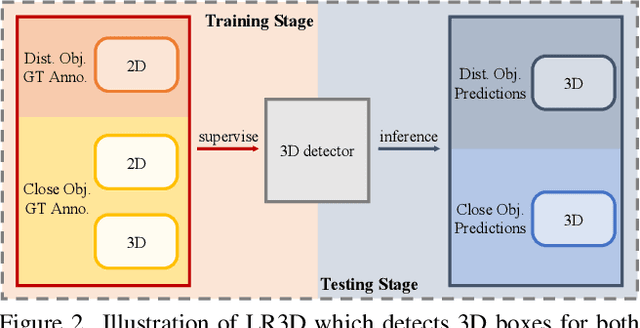
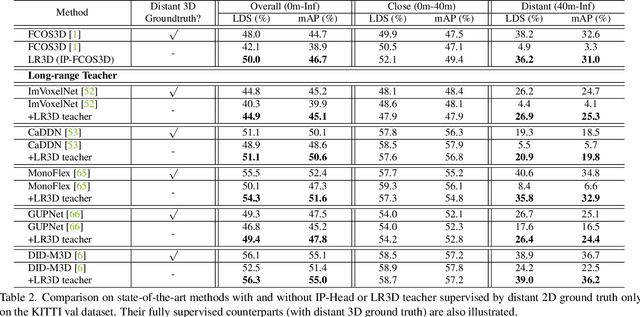
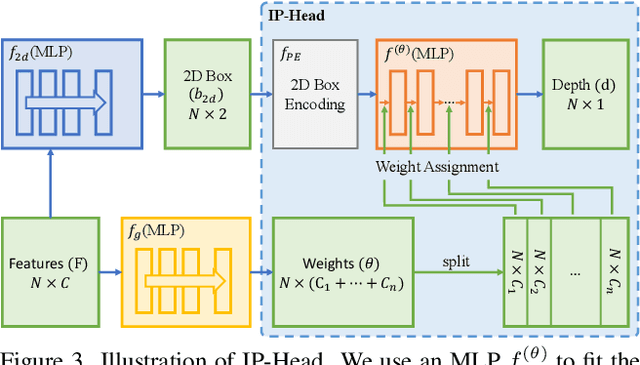
Abstract:Improving the detection of distant 3d objects is an important yet challenging task. For camera-based 3D perception, the annotation of 3d bounding relies heavily on LiDAR for accurate depth information. As such, the distance of annotation is often limited due to the sparsity of LiDAR points on distant objects, which hampers the capability of existing detectors for long-range scenarios. We address this challenge by considering only 2D box supervision for distant objects since they are easy to annotate. We propose LR3D, a framework that learns to recover the missing depth of distant objects. LR3D adopts an implicit projection head to learn the generation of mapping between 2D boxes and depth using the 3D supervision on close objects. This mapping allows the depth estimation of distant objects conditioned on their 2D boxes, making long-range 3D detection with 2D supervision feasible. Experiments show that without distant 3D annotations, LR3D allows camera-based methods to detect distant objects (over 200m) with comparable accuracy to full 3D supervision. Our framework is general, and could widely benefit 3D detection methods to a large extent.
Rethinking Patch Dependence for Masked Autoencoders
Jan 25, 2024



Abstract:In this work, we re-examine inter-patch dependencies in the decoding mechanism of masked autoencoders (MAE). We decompose this decoding mechanism for masked patch reconstruction in MAE into self-attention and cross-attention. Our investigations suggest that self-attention between mask patches is not essential for learning good representations. To this end, we propose a novel pretraining framework: Cross-Attention Masked Autoencoders (CrossMAE). CrossMAE's decoder leverages only cross-attention between masked and visible tokens, with no degradation in downstream performance. This design also enables decoding only a small subset of mask tokens, boosting efficiency. Furthermore, each decoder block can now leverage different encoder features, resulting in improved representation learning. CrossMAE matches MAE in performance with 2.5 to 3.7$\times$ less decoding compute. It also surpasses MAE on ImageNet classification and COCO instance segmentation under the same compute. Code and models: https://crossmae.github.io
Test-Time Training on Video Streams
Jul 12, 2023



Abstract:Prior work has established test-time training (TTT) as a general framework to further improve a trained model at test time. Before making a prediction on each test instance, the model is trained on the same instance using a self-supervised task, such as image reconstruction with masked autoencoders. We extend TTT to the streaming setting, where multiple test instances - video frames in our case - arrive in temporal order. Our extension is online TTT: The current model is initialized from the previous model, then trained on the current frame and a small window of frames immediately before. Online TTT significantly outperforms the fixed-model baseline for four tasks, on three real-world datasets. The relative improvement is 45% and 66% for instance and panoptic segmentation. Surprisingly, online TTT also outperforms its offline variant that accesses more information, training on all frames from the entire test video regardless of temporal order. This differs from previous findings using synthetic videos. We conceptualize locality as the advantage of online over offline TTT. We analyze the role of locality with ablations and a theory based on bias-variance trade-off.
Programmatically Grounded, Compositionally Generalizable Robotic Manipulation
Apr 26, 2023
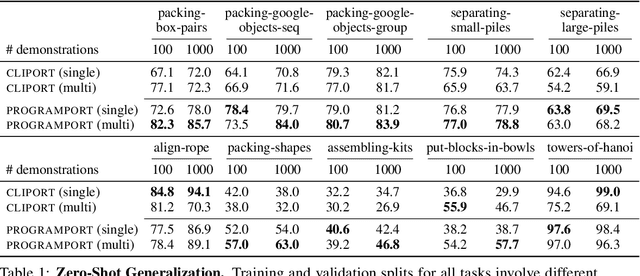
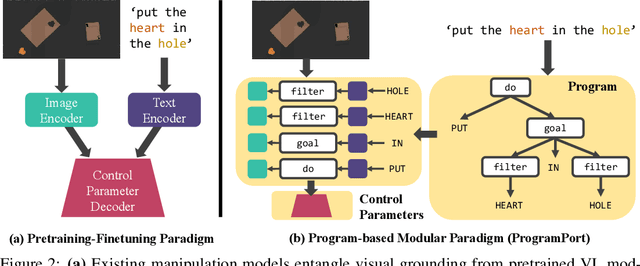

Abstract:Robots operating in the real world require both rich manipulation skills as well as the ability to semantically reason about when to apply those skills. Towards this goal, recent works have integrated semantic representations from large-scale pretrained vision-language (VL) models into manipulation models, imparting them with more general reasoning capabilities. However, we show that the conventional pretraining-finetuning pipeline for integrating such representations entangles the learning of domain-specific action information and domain-general visual information, leading to less data-efficient training and poor generalization to unseen objects and tasks. To this end, we propose ProgramPort, a modular approach to better leverage pretrained VL models by exploiting the syntactic and semantic structures of language instructions. Our framework uses a semantic parser to recover an executable program, composed of functional modules grounded on vision and action across different modalities. Each functional module is realized as a combination of deterministic computation and learnable neural networks. Program execution produces parameters to general manipulation primitives for a robotic end-effector. The entire modular network can be trained with end-to-end imitation learning objectives. Experiments show that our model successfully disentangles action and perception, translating to improved zero-shot and compositional generalization in a variety of manipulation behaviors. Project webpage at: \url{https://progport.github.io}.
For Pre-Trained Vision Models in Motor Control, Not All Policy Learning Methods are Created Equal
Apr 10, 2023
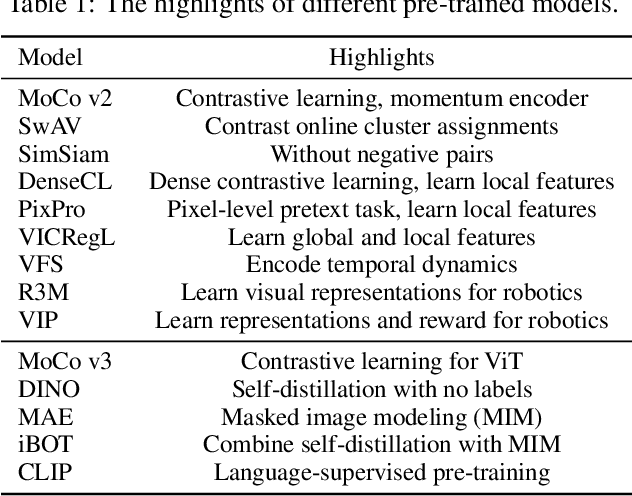


Abstract:In recent years, increasing attention has been directed to leveraging pre-trained vision models for motor control. While existing works mainly emphasize the importance of this pre-training phase, the arguably equally important role played by downstream policy learning during control-specific fine-tuning is often neglected. It thus remains unclear if pre-trained vision models are consistent in their effectiveness under different control policies. To bridge this gap in understanding, we conduct a comprehensive study on 14 pre-trained vision models using 3 distinct classes of policy learning methods, including reinforcement learning (RL), imitation learning through behavior cloning (BC), and imitation learning with a visual reward function (VRF). Our study yields a series of intriguing results, including the discovery that the effectiveness of pre-training is highly dependent on the choice of the downstream policy learning algorithm. We show that conventionally accepted evaluation based on RL methods is highly variable and therefore unreliable, and further advocate for using more robust methods like VRF and BC. To facilitate more universal evaluations of pre-trained models and their policy learning methods in the future, we also release a benchmark of 21 tasks across 3 different environments alongside our work.
Robust and Controllable Object-Centric Learning through Energy-based Models
Oct 11, 2022


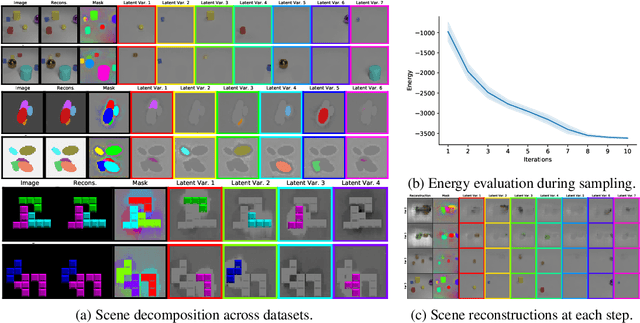
Abstract:Humans are remarkably good at understanding and reasoning about complex visual scenes. The capability to decompose low-level observations into discrete objects allows us to build a grounded abstract representation and identify the compositional structure of the world. Accordingly, it is a crucial step for machine learning models to be capable of inferring objects and their properties from visual scenes without explicit supervision. However, existing works on object-centric representation learning either rely on tailor-made neural network modules or strong probabilistic assumptions in the underlying generative and inference processes. In this work, we present \ours, a conceptually simple and general approach to learning object-centric representations through an energy-based model. By forming a permutation-invariant energy function using vanilla attention blocks readily available in Transformers, we can infer object-centric latent variables via gradient-based MCMC methods where permutation equivariance is automatically guaranteed. We show that \ours can be easily integrated into existing architectures and can effectively extract high-quality object-centric representations, leading to better segmentation accuracy and competitive downstream task performance. Further, empirical evaluations show that \ours's learned representations are robust against distribution shift. Finally, we demonstrate the effectiveness of \ours in systematic compositional generalization, by re-composing learned energy functions for novel scene generation and manipulation.
 Add to Chrome
Add to Chrome Add to Firefox
Add to Firefox Add to Edge
Add to Edge